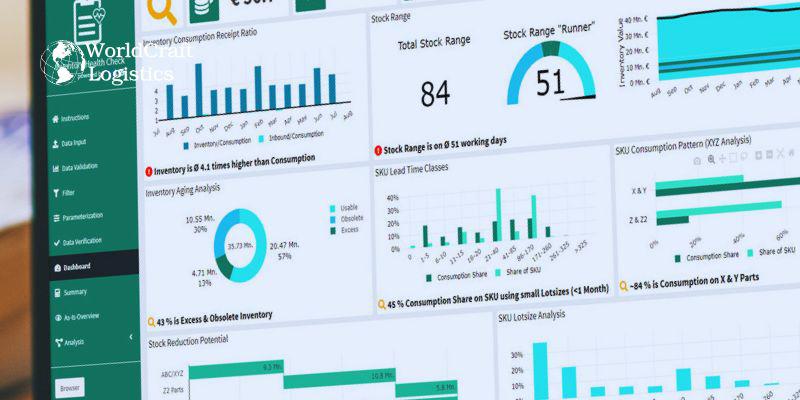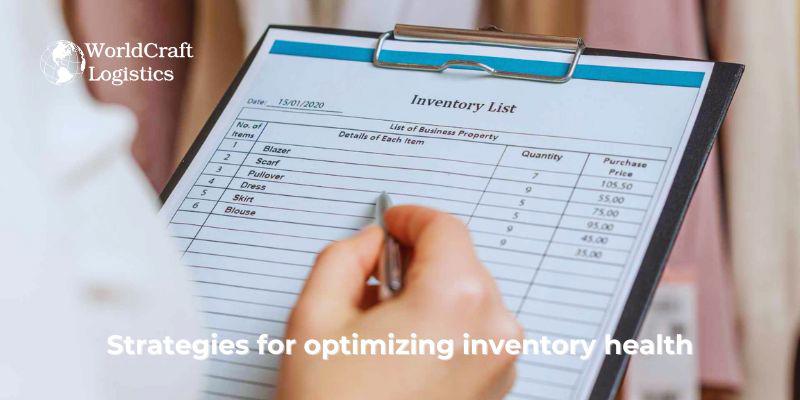
Starting June 1st, 2023 Our warehouse fee will be $0.65/cubic foot per month
In effort to lower the warehouse storage fee during inflation, we have went narrow aisle racking.This construction took us four months but the project is finally completed. With narrow aisle racking, we are able to drop storage by 24%.We as partners will go through this inflation together.
04/15/2024
Enhancing inventory health might seem straightforward for retailers. The task entails finely tuning stock quantities to match consumer needs while keeping expenses in check. However, in reality, inventory management is a complex endeavor fraught with challenges.
Conversely, an excess of inventory leads to capital being immobilized. Nonetheless, retailers can deploy crucial tactics to enhance stock optimization and satisfy customer requirements.
Within this piece, we'll scrutinize key factors pivotal in inventory analysis within retail operations and offer a comprehensive guide for diagnosing and enhancing inventory health. Let's delve deeper!

In the realm of retail, maintaining a healthy inventory is pivotal, necessitating a delicate equilibrium between stock levels, consumer demand, and operational expenses. A robust inventory ensures products are readily available to meet consumer needs, steering clear of both stockouts and superfluous overstock.
Generally, retailers strive to fine-tune inventory levels to achieve several objectives:
✍️ Efficient capital employment: Averts capital tie-up in surplus stock, thereby enhancing cash flow.
✍️ Optimized storage allocation: Curbs overstocking, thereby maximizing warehouse space utilization.
✍️ Minimized spoilage and obsolescence: Particularly vital for perishable or trend-sensitive merchandise.
✍️ Synchronized supply and demand: Guarantees stock levels are in tune with consumer demands, avoiding surplus accumulation.
"Inventory" and its terms are always of interest to many people. They will learn thoroughly to easily manage their business's warehouse operations. Read more articles below to cultivate new knowledge:
👉 Inventory Forecasting: Definition, types, best practices & benefits
👉 What is Digital Inventory & Why is it important with Ecommerce
👉 What is consignment inventory? Benefits and effective ways

Keeping tabs on crucial inventory key performance indicators (KPIs) is imperative for maintaining the health of your inventory. These metrics offer valuable insights into the efficacy of your inventory management. Let's delve into the primary indicators of inventory health and examine effective monitoring strategies.
The inventory turnover ratio, a crucial metric in assessing business performance, gauges the frequency with which inventory is sold and replenished within a given timeframe. A heightened turnover signifies adept inventory management and robust sales efficacy. To track this ratio:
Compute: Divide the cost of goods sold (COGS) by the average inventory value.
The Days Sales of Inventory (DSI) reflects the average duration required to sell the complete inventory, with a lower DSI indicating quicker turnover, a preference in most cases. To track DSI:
Utilize Calculation: Divide the number of days within the specified time period by the inventory turnover ratio.
Stockouts denote the circumstance wherein an item is absent from inventory, rendering it unavailable for purchase, thereby resulting in missed sales opportunities. Monitoring Stockouts:
Surveillance: Maintain a log of occasions when customer demands go unfulfilled due to product unavailability.
Holding costs encompass various expenditures associated with maintaining unsold inventory, such as warehousing, insurance, and depreciation. To effectively monitor these expenses, businesses should undertake the following steps:
Calculation: Aggregate the costs incurred for storage, handling, insurance, and taxes pertaining to inventory.
Lead time, crucial in supply chain management, signifies the duration between placing an order and receiving inventory, or from customer purchase to delivery. Reducing lead times improves inventory agility. Monitoring lead times involves:
Tracking: Observing the timeframe from order placement to receipt.

Numerous ubiquitous threats loom over inventory well-being. Encouragingly, proactive measures like employing appropriate tools, partnering strategically, and implementing effective strategies can frequently neutralize these risks.
☑️ Overstocking: Overstocking, a phenomenon observed in businesses, arises when a company accumulates excess inventory beyond market demand. This practice not only immobilizes capital but also escalates holding expenses, while simultaneously posing the risk of inventory obsolescence or spoilage.
☑️ Improper Forecasting of Demand: Faulty demand predictions can result in either excess inventory or shortages. Both outcomes are detrimental: surplus ties up resources, while deficits cause lost sales and customer discontent.
☑️ Supply chain inefficiencies: Supply chain inefficiencies, including procurement delays, transportation hiccups, or manufacturing setbacks, have the potential to disrupt inventory flow and result in stock problems.
☑️ Neglecting seasonal trends: Neglecting seasonal demand shifts may lead to surplus inventory after the season or insufficient stock during peak demand periods.
☑️ Regulatory non-compliance: Failure to adhere to industry regulations can lead to penalties, legal entanglements, and disruptions in operations, affecting the management of inventory.
☑️ Cybersecurity weak spots: Cybersecurity vulnerabilities have the potential to result in data breaches, jeopardizing inventory management systems and causing disruptions to operations.
Effective inventory management serves as a strategic asset in the retail sector, offering a competitive edge. Businesses can gain significant advantages by analyzing and enhancing inventory health, extending beyond mere operational efficiency. Here's a breakdown of the key benefits derived from optimizing inventory levels.
Retailers can mitigate overstock dilemmas by diagnosing and enhancing inventory health. This proactive approach aids in averting situations where surplus stock languishes unsold. Decreasing excess inventory not only slashes holding and storage expenses across warehouses, distribution centers (DCs), and retail outlets but also mitigates the peril of accumulating dead stock, which would otherwise necessitate disposal or sale at a loss.
Maximizing warehouse or retail floor space through optimized storage solutions is crucial for cost efficiency and accommodating new inventory. It's imperative for retailers to minimize wasted space and strategically organize their inventory for optimal operations.

As inventory ages, its value depreciates gradually. To enhance profitability throughout the product lifecycle, it's crucial to offload inventory while it remains attractive and in demand among customers. Retailers aim to mitigate the presence of outdated or unsellable stock. Through strategic management of stock levels across the product lifecycle, businesses mitigate the risks associated with inventory obsolescence.
Efficient inventory management is crucial for maximizing cash flow by minimizing excess inventory, thereby freeing up capital. This, in turn, empowers retailers to channel more funds towards various facets of their business operations.
Stock shortages may result in customer dissatisfaction. Maintaining optimal inventory levels guarantees that customers can locate desired items promptly, bolstering satisfaction and fostering brand allegiance. Consequently, businesses can expect increased repeat patronage and augmented customer lifetime value (LTV).

Having delineated some prevalent inventory health risks, it's pertinent to delve into actionable tactics for enhancing inventory health, enabling proactive mitigation of these challenges. Here are seven strategies to optimize your inventory's well-being.
Employing data analytics for demand forecasting entails scrutinizing sales history, market trends, planned promotions, and external influences to precisely anticipate future product demand. Leveraging forecasting tools to analyze this data facilitates the identification of demand trends, empowering businesses to proactively adjust their inventory levels.
Establishing automated reorder points stands as a pivotal tactic for upholding optimal inventory levels. This process entails computing reorder thresholds by factoring in demand throughout lead time alongside safety stock. A proficient inventory management framework can mechanize reorder alerts, guaranteeing prompt replenishment and mitigating the likelihood of inventory shortages.

Enabling a real-time inventory monitoring infrastructure is indispensable for contemporary e-commerce enterprises, providing timely stock data essential for operations. Such systems facilitate instantaneous updates on stock levels and issue alerts for low inventory. This live monitoring and alert mechanism empower businesses to promptly respond to fluctuations in their inventory.
Deploying a distributed inventory system across numerous fulfillment centers marks a strategic maneuver that bolsters inventory management. This tactic not only slashes shipping durations but also serves as a contingency plan for inventory management. For instance, should one warehouse experience dwindling stocks of a particular product, another facility can step in to maintain uninterrupted product availability.
Regular inventory audits are imperative to guarantee inventory precision and pinpoint possible concerns. Scheduled physical counts must align with inventory records, and an ABC analysis should be conducted to classify inventory according to significance and value. Consistent auditing is vital for upholding precise inventory records, a fundamental aspect of efficient inventory management.
Delving into AI and machine learning solutions presents an avenue for enhanced inventory analysis, surpassing conventional approaches. The integration of AI tools facilitates predictive analytics and trend recognition, whereas machine learning algorithms streamline facets of inventory optimization, guaranteeing a more accurate strategy for stock management.
Selecting robust inventory management software is essential for optimizing inventory processes. Firms must opt for a solution that seamlessly integrates with their online retail infrastructure and delivers up-to-the-minute inventory insights. Such software plays a pivotal role in facilitating well-informed choices that directly influence inventory management, including strategic reorder timings, identification of sluggish-moving products, and averting both excess stock and stock shortages.
SEO
Digital Marketing/SEO Specialist
Simon Mang is an SEO and Digital Marketing expert at Wordcraft Logistics. With many years of experience in the field of digital marketing, he has shaped and built strategies to effectively promote Wordcraft Logistics' online presence. With a deep understanding of the logistics industry, I have shared more than 500 specialized articles on many different topics.

Education
01/05/2025

Education
02/18/2025

Education
01/01/2024

Education
08/28/2024

Education
11/13/2023